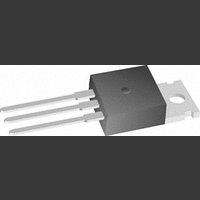LM1084IS-5.0 National Semiconductor, LM1084IS-5.0 Datasheet - Page 8

LM1084IS-5.0
Manufacturer Part Number
LM1084IS-5.0
Description
Linear Voltage Regulator IC
Manufacturer
National Semiconductor
Datasheets
1.LM1084ISX-ADJ.pdf
(13 pages)
2.LM1084ISX-ADJ.pdf
(13 pages)
3.LM1084ISX-ADJ.pdf
(14 pages)
Specifications of LM1084IS-5.0
No. Of Pins
3
Output Current
1.5A
Termination Type
Through Hole
Mounting Type
Through Hole
Voltage Regulator Type
LDO Linear
Peak Reflow Compatible (260 C)
No
Supply Voltage
29V
Current Rating
5A
Lead Free Status / RoHS Status
Contains lead / RoHS non-compliant
Available stocks
Company
Part Number
Manufacturer
Quantity
Price
Company:
Part Number:
LM1084IS-5.0
Manufacturer:
NS
Quantity:
500
www.national.com
APPLICATION NOTE
General
Figure 1 shows a basic functional diagram for the
LM1084-Adj (excluding protection circuitry) . The topology is
basically that of the LM317 except for the pass transistor. In-
stead of a Darlingtion NPN with its two diode voltage drop,
the LM1084 uses a single NPN. This results in a lower drop-
out voltage. The structure of the pass transistor is also
known as a quasi LDO. The advantage a quasi LDO over a
PNP LDO is its inherently lower quiescent current. The
LM1084 is guaranteed to provide a minimum dropout volt-
age 1.5V over temperature, at full load.
Output Voltage
The LM1084 adjustable version develops at 1.25V reference
voltage, (V
As shown in figure 2, this voltage is applied across resistor
R1 to generate a constant current I1. This constant current
then flows through R2. The resulting voltage drop across R2
adds to the reference voltage to sets the desired output volt-
age.
The current I
output error . But since it is small (120uA max), it becomes
negligible when R1 is in the 100
For fixed voltage devices, R1 and R2 are integrated inside
the devices.
Stability Consideration
Stability consideration primarily concern the phase response
of the feedback loop. In order for stable operation, the loop
must maintain negative feedback. The LM1084 requires a
certain amount series resistance with capacitive loads. This
series resistance introduces a zero within the loop to in-
FIGURE 1. Basic Functional Diagram for the LM1084,
FIGURE 2. Basic Adjustable Regulator
REF
ADJ
excluding Protection circuitry
), between the output and the adjust terminal.
from the adjustment terminal introduces an
range.
DS100946-17
DS100946-65
8
crease phase margin and thus increase stability. The equiva-
lent series resistance (ESR) of solid tantalum or aluminum
electrolytic capacitors is used to provide the appropriate zero
(approximately 500 kHz).
The Aluminum electrolytic are less expensive than tantal-
ums, but their ESR varies exponentially at cold tempera-
tures; therefore requiring close examination when choosing
the desired transient response over temperature. Tantalums
are a convenient choice because their ESR varies less than
2:1 over temperature.
The recommended load/decoupling capacitance is a 10uF
tantalum or a 50uF aluminum. These values will assure sta-
bility for the majority of applications.
The adjustable versions allows an additional capacitor to be
used at the ADJ pin to increase ripple rejection. If this is done
the output capacitor should be increased to 22uF for tantal-
ums or to 150uF for aluminum.
Capacitors other than tantalum or aluminum can be used at
the adjust pin and the input pin. A 10uF capacitor is a rea-
sonable value at the input. See Ripple Rejection section re-
garding the value for the adjust pin capacitor.
It is desirable to have large output capacitance for applica-
tions that entail large changes in load current (microproces-
sors for example). The higher the capacitance, the larger the
available charge per demand. It is also desirable to provide
low ESR to reduce the change in output voltage:
It is common practice to use several tantalum and ceramic
capacitors in parallel to reduce this change in the output volt-
age by reducing the overall ESR.
Output capacitance can be increased indefinitely to improve
transient response and stability.
Ripple Rejection
Ripple rejection is a function of the open loop gain within the
feed-back loop (refer to Figure 1 and Figure 2 ). The LM1084
exhibits 75dB of ripple rejection (typ.). When adjusted for
voltages higher than V
function of adjustment gain: (1+R1/R2) or V
fore a 5V adjustment decreases ripple rejection by a factor of
four (−12dB); Output ripple increases as adjustment voltage
increases.
However, the adjustable version allows this degradation of
ripple rejection to be compensated. The adjust terminal can
be bypassed to ground with a capacitor (C
ance of the C
desired ripple frequency. This bypass capacitor prevents
ripple from being amplified as the output voltage is in-
creased.
1/(2
Load Regulation
The LM1084 regulates the voltage that appears between its
output and ground pins, or between its output and adjust
pins. In some cases, line resistances can introduce errors to
the voltage across the load. To obtain the best load regula-
tion, a few precautions are needed.
Figure 3 shows a typical application using a fixed output
regulator. Rt1 and Rt2 are the line resistances. V
than the V
resistances. In this case, the load regulation seen at the
R
LOAD
*
V = I x ESR
f
RIPPLE
would be degraded from the data sheet specification.
OUT
*
ADJ
C
by the sum of the voltage drops along the line
ADJ
should be equal to or less than R1 at the
)
REF
R
1
, the ripple rejection decreases as
ADJ
O
/V
). The imped-
REF
LOAD
. There-
is less













